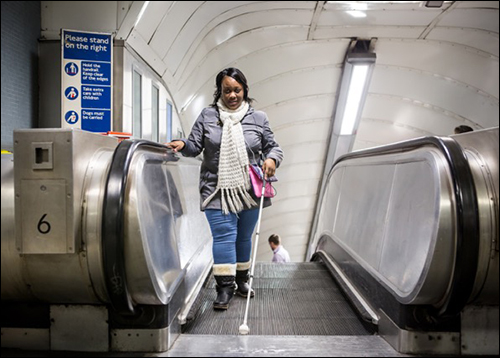Until recently, Kevin Satizabal, a 25-year-old musician and online communities assistant for a nonprofit in London, could never visit a subway station without help. And he’d probably never do so at night, when finding assistance is more difficult.
That’s because for a vision-impaired commuter, moving through an unfamiliar tube stop, with its many twists and turns, stairs and platforms, can be terrifying.

But last year, Satizabal entered the subway at London’s bustling Pimlico station without the help of a companion—or, at least, not a human one. Wearing a pair of bone-conduction headphones, which enable a wearer to listen to electronic devices without blocking out ambient sounds or conversations, Satizabal was guided through the station by a navigation app on his smartphone, and by a network of Bluetooth beacons deployed throughout the station.
That app was designed by digital product studio ustwo. It was dubbed Wayfindr, which also came to be the name of a nonprofit that ustwo launched following a 2014 collaboration with the Royal London Society for Blind People (RLSB). Wayfindr, the nonprofit, is supported by a $1 million grant from Google’s philanthropic arm, Google.org. Earlier this month, the group announced that it is offering app developers a kit that includes a demo app and guidelines, and is designed to encourage transit agencies to launch beacon-based audio navigation systems using the standard. Wayfindr hopes that its deployment guidelines will become an open standard for beacon-based public-transit navigation apps.
Wayfindr and its technology partners have also been testing apps based on the open standard, in partnership with public-transport agencies in London and Sydney.
Satizabal, whose employer is the RLSB, told me that he’s not had great luck with other navigation systems he has tried because the verbal instructions tended to come slowly, leaving him waiting for the next step and unsure of where he is at any given moment. He and other vision-impaired individuals tested and evaluated iterations of the app at Pimlico and other London subway stations, providing feedback to the app developers. That feedback was incorporated into the app design and the Wayfindr standard. When Satizabal tested the Wayfindr-based app in the subway, he says, the navigation instructions were transmitted at exactly the right times. The accuracy—enabled by a dense network of Bluetooth beacons installed throughout the Pimlico station—was precise enough to tell him when the escalator he was on was halfway to its destination, or how many steps remained before he reached the top of the staircase.
The RLSB says sight loss takes a toll on the U.K. economy, so anything that improves accessibility is like a tide raising all ships. In 2008, it estimates, the economic impact of sight loss was £6.5 billion ($9.5 billion), with costs related to health care and the amount of caregivers’ time that is unpaid, but also to the reduced employment rates that vision-impaired citizens receive. While neither the mobile application that ustwo has developed, nor the standardization effort that Wayfindr is providing, will close that opportunity/salary gap, I think both could help vision-impaired commuters feel more empowered.
Since they are unable to drive, vision-impaired people are heavily reliant on buses, subways and trains. But multiple studies have shown that they have trouble accessing and navigating such public-transit systems. According to a 2008 report commissioned by London’s Royal National Institute for the Blind, 45 percent of vision-impaired people required advice on travel during the first year following diagnosis, but only 23 percent said they were offered mobility training to help them get around independently.
Wayfinding signs and maps do include some Braille-based information, but that is a far cry from the granular navigation that a smartphone app can provide. Public-transit agencies offer assistance to vision-impaired users, but that generally requires a commuter to make arrangements to meet an agency staffer to provide physical guidance. And then there are the unique configurations and variations in the layouts of the stations, which were not necessarily designed to provide sonic cues to commuters.
Here’s what Nik Pollinger, a media relations rep who works for Wayfindr, told me via e-mail:
“Some forms of public transport are practically speaking harder to access, in particular the subway because of obstacles such as escalators, crowds and reading timetable information. This may disincline a vision-impaired person from trying because of the effort and time it would take. On the psychological front, being sighted I was myself surprised to learn that it is inappropriate to ask someone using a cane if they require assistance (because they have always been polite in declining). They will get numerous such offers on any trip and really what they tend to want is to feel autonomous and independent—only asking for help if they need it.”
If the Wayfindr standard is widely deployed and used for navigation apps in transit agencies around the world, that doesn’t just mean it will be easier for people like Satizabal to get to work or to meet friends for a post-work beer in London—it will make using public transit while visiting other cities easier, too. That means the technology will have add-on benefits for transit-accessible businesses as well.
It will take time and investment for businesses, as well as transit and service providers, to build out beacon infrastructures and create applications, Satizabal reminded me. But he added: “Eventually, this investment would be good for everybody.”
Mary Catherine O’Connor is the editor of IoT Journal and a former staff reporter for RFID Journal. She also writes about technology, as it relates to business and the environment, for a range of consumer magazines and newspapers.


